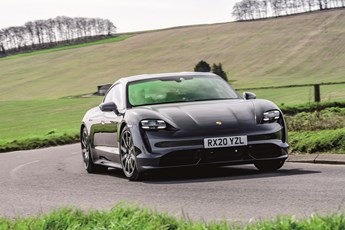We use cookies to ensure that we give you the best experience on our website. If you continue without changing your settings, we will assume that you are happy to receive all cookies on the Business Car website. However, if you would like to, you can change your cookies at any time

The start point for the best source of fleet information |
First drive: Porsche Taycan Turbo
Date: 28 June 2022 | Author: Martyn Collins

|
|
||||||||||||||||
We drove the more recent Audi E-Tron GT back in the April issue, but at the time we had not had the chance to compare it with the Taycan - which shares the Audi's J1 underpinnings. The Audi impressed us with its performance, handling and the drive. How different, we asked could the Porsche be? Quite different, it turns out.
Outside, the front charging points, glass area and overall dimensions are similar to the Audi, but elsewhere the Porsche very much has its own style. Visual links with the 2015 Mission E, of which the Taycan is a production version, are obvious. Highlights are the interesting oval front headlights that merge into distinctive air intakes around them. There is also a distinctive lower air dam, too.
The side looks more stretched 911 than electric Panamera - with its distinctive front and rear haunches and large air duct at the front to cool the brakes. At the back, the high-set rear light bar shouts 911 and like the E-Tron GT there's also a spoiler that pops up at speed.
Inside, the Taycan's interior feels more special and more modern than the Audi. Mostly made up of screens, a sculptural oval one sits right in the driver's line for instruments, on top rather than being sunken into the dashboard.
There's another smaller 10.9in screen for navigation next to it and another lower, more rectangular screen to control other items such as the ventilation in the raised centre console.
The low but multi-adjustable driving position is similar to the Audi - but the Taycan's sports seats feel more supportive and remind me more of the last time I drove a Porsche 911.
Move to the back, and like with the E-Tron GT, space in the rear is perfectly acceptable for two children or averagely-sized adults - although the tallest will find their heads brushing the edge of the glass roof.
Interestingly, there is actually less boot space in the Porsche than the Audi, 366 versus 405 litres. Although, that again can be extended with the folding rear seats. Like with the Audi, that boot has an awkward opening, making loading some items difficult. More luggage space can be found with the 'frunk' under the bonnet, although if you still need more space, the estate-like Cross Turismo variant might be more suitable.
We had a drive in the Turbo, with 616hp and a whopping 850Nm of torque. Although you can go further with the frankly unbelievable 751hp Turbo S. Still, this Turbo's considerable performance is transmitted to the road via two electric motors. This means eye-watering 62mph acceleration in just three seconds and a licence-losing top speed of 161mph. Yet despite all this performance, it is still capable of 252 miles on a charge - although like the E-Tron GT, if you make use of the performance, realistically the range is closer to 220 miles.
Talking about charging, the Taycan Turbo is fitted with the performance battery plus option, which increases the maximum charging rate from 225kW to 270kW, meaning in theory that you could charge from 10-80% in just 20 minutes.
We say, 'in theory', as the reality is that there are very few 270kW charging stations currently available, but a 100kW charger will still take this Porsche's battery from 10-80% in around 40 minutes. Or 13.5hrs, if you are using a 7kW home wall box charger.
The Taycan weighs a rather lardy 2,305kg, but those batteries are cleverly placed low down in the body and as such, offers a drive that's worthy of the Porsche badge.
The most obvious change between the Taycan and the E-Tron GT is with the steering system. Porsche's engineers have dialled in a touch more weight, adding an extra layer of feel, making it even more accurate.
Considering the ride on the air suspension and that the 21in alloy wheels are so comfortable and compliant in anything other than the 'Sport' modes, it is almost unbelievable that this Taycan corners with virtually no body roll. Yet it is surprisingly restful and docile when you do not need the performance.
This Porsche is impressively easy to drive too; slot in the key, flick the toggle on the right into drive (much like the way you select gears in the new Volkswagen Multivan, also driven in this issue on p34) and off you go.
Like the Audi, the Porsche impresses with its own character, which is more overtly sporty. Yet, it's easy to drive and undemanding if you want it to be.
The Taycan has to be one of the most complete performance EVs available, although for fleet, the two-wheel drive Taycan and four-wheel drive Taycan 4S make more sense to us.
Porsche Taycan Turbo
P11D: £116,870
Residual value: 56.4%
Depreciation: £50,967
Fuel: £4,736
Service, maintenance and repair: £10,486
Cost per mile: 110.31p
Range: 252 miles
CO2 (BIK %): 0g/km (2%)
BIK 20/40% a month: £39/£80
Luggage capacity: 366 litres
Battery size/power: 93.4kWh/671hp
Verdict |
9/10 |
|||
 |
|
 |
|
|











